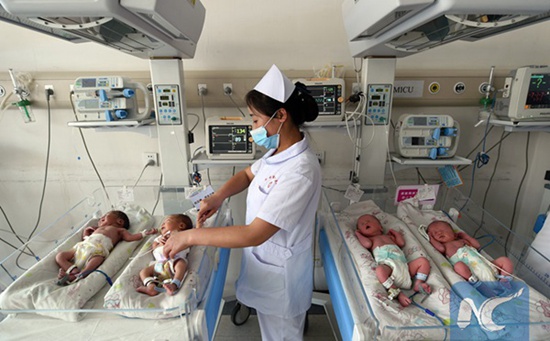

 |
China's newborn population grew to 16.87 million in 2014, thanks partly to the country's relaxation of the "one-child" policy, a health official said at a press conference on Friday.
There were almost 1 million more newborns in 2014, compared to 15.92 million in 2010, Yang Wenzhuang, a deputy-director at the National Health and Family Planning Commission, said.
He said the increase was prompted by a bigger population of women of in the primary child-bearing age, as well as the country's relaxation of the "one-child" policy.
China's total population reached 1.368 billion by the end of 2014, according to Yang. The country has been reining in a population surge with family planning policies.
It first introduced the policy in the late 1970s, limiting most urban couples to one child and most rural couples to two if the first child was a girl.
A major policy change was adopted at the end of 2013, stipulating that couples nationwide may now have a second child if either parent is an only child.
Yang said China saw a decreasing number of first children being born but an increase of second children, without specifying the margins.
The policy adjustment came after concerns of rapid aging population and shrinking working population.
According to the latest population structure revealed by Yang, China's working age population, those between 15 and 59, fell to 930 million in 2014 from its peak of 940 million in 2011.
However, Yang said, the working age population is still large, twice that of Europe, and more than the aggregate of all developed nations.
The elderly, those above 60 years old, on the other hand, reached 212 million in 2014, representing 15.5 percent of the total population, whereas the group accounted for 13.3 percent of the total in 2010.
Those between 0 to 14 years old took up 16.5 percent of the entire population, lower than the world average of 26 percent, but equal to developed countries.
The total fertility rate (TFR), or the number of children that would be born to a woman of child-bearing age, "rose a little" from 1.5 to 1.65 percent in 2014, Yang said.
A TFR lower than 1.3 percent is regarded as extremely low fertility which is detrimental to a country's population sustainability.
A 2010 census revealed an alarming TFR of 1.18 percent, falling into the extremely-low-fertility bracket. However, Song Jian, a Renmin University professor, said the census may have missed some people and China's TFR has been stabilized at around 1.5 percent since.
Gender imbalance due to couples preferring male children also fell for the sixth year in a row, falling to 115.88 males for every 100 females in 2014, Yang said.
 Top 10 summer resorts across China
Top 10 summer resorts across China Campus belle in HK goes viral online
Campus belle in HK goes viral online Get ready for the world's most thrilling water rides
Get ready for the world's most thrilling water rides Evolution of Chinese beauties in a century
Evolution of Chinese beauties in a century Creative graduation caps of ‘vigorous elves’
Creative graduation caps of ‘vigorous elves’ Typhoon class strategic Submarine in photos
Typhoon class strategic Submarine in photos Japan’s crimes committed against "comfort women"
Japan’s crimes committed against "comfort women" Legendary life of a bee-keeping master in Hainan
Legendary life of a bee-keeping master in Hainan 4-year-old cute 'monk' spends summer holiday in temple
4-year-old cute 'monk' spends summer holiday in temple Top 10 most competitive Chinese cities in Belt and Road Initiative
Top 10 most competitive Chinese cities in Belt and Road Initiative Top 10 travel destinations in the world
Top 10 travel destinations in the world Promote reform as stock market stabilizes
Promote reform as stock market stabilizes Taking stock: the ups and downs of Chinese shareholders
Taking stock: the ups and downs of Chinese shareholders Small rise in CPI shows growth still slack: experts
Small rise in CPI shows growth still slack: experts Donations struggle to grow after China stops getting organs from executed prisoners
Donations struggle to grow after China stops getting organs from executed prisonersDay|Week